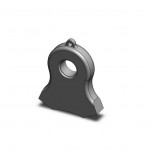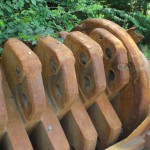Pin Protectors are Vital Wear Parts
Disk rotor scrap metal shredders run with 1-2 hammers in each row and cover the remaining positions with pin protectors. Are pin protectors important wear parts that contribute to wear life? Absolutely.
The role of pin protectors:
- Job one is protecting expensive hammer pins where no hammer exists.
- They assist in crushing and densifying scrap in the shredder.
- They help protect the rotor disks, limiting disk wear.
- They help maintain rotational energy of the rotor. The weight of many pin protectors on the outer edges of the rotor make up the ‘flywheel’ that is your shredder rotor.
When new, pin protectors should extend about 2-4 inches past the disk. Disk rotors are more forgiving on balance, but the closer you can match weights of opposing rows of pins and hammers, the better off you will be. Some operators have favored larger protectors as a way to help gain rotating mass and “store” more rotational energy. As with everything, there are limits. Your shredder manufacturer can give you guidance on how much is too much for your mill size, rotor, and drive line.
Bottom line, don’t neglect pin protectors. They are not just ‘along for the ride.’ With a little tweaking on size and weight, they can help maintain rotational energy and help save wear on your inner disks as well. Give us a call and let us help you find an edge in improved performance.

 many potential positions, in the majority of applications it is best in terms of performance and reduced wear parts cost, to use fewer
many potential positions, in the majority of applications it is best in terms of performance and reduced wear parts cost, to use fewer 


